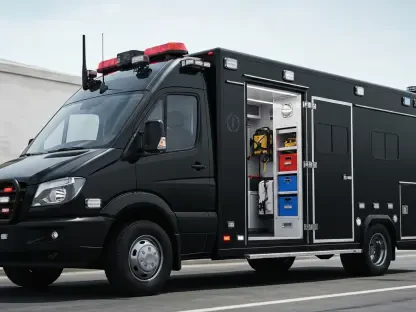In the vast, rugged landscapes of America’s wildlands, firefighters battle blazes under conditions that test both human endurance and technological capability, often in areas where cellular signals are nonexistent and communication becomes a lifeline. The U.S. Forest Service, tasked with protecting these regions, faces a critical challenge as it strives to modernize the tools and systems essential for wildfire response. However, recent staffing reductions, driven by federal policy decisions, have created significant roadblocks in upgrading vital communications and resource tracking technologies. These cuts, compounded by hiring freezes and budget uncertainties, have left the agency struggling to maintain momentum on innovative projects. From portable cellular towers to satellite systems, the promise of cutting-edge solutions hangs in the balance, raising concerns about the safety and efficiency of those on the front lines. This issue demands a closer look at how workforce shortages are directly impacting the ability to protect both firefighters and the lands they defend.
Technological Innovations Under Threat
The operational environment for wildland firefighters presents unique hurdles, with remote forested areas often lacking reliable cellular coverage, forcing reliance on radios and GPS for critical communication and tracking. The Forest Service has been exploring groundbreaking solutions to bridge these gaps, such as deploying portable cellular towers and partnering with NASA to test stratospheric balloons for enhanced imaging and coverage. Additionally, low-earth orbit satellite systems have been under consideration to provide real-time data in isolated regions. These advancements could revolutionize how firefighting teams coordinate and respond to rapidly changing fire conditions. Yet, the progress of these initiatives has been severely hampered by a lack of personnel to oversee development and implementation. Without adequate staffing, the agency struggles to move from concept to reality, leaving firefighters with outdated tools that may not meet the demands of increasingly intense wildfire seasons. The gap between innovation and execution continues to widen under these constraints.
Another critical area affected is the acquisition and deployment of individual GPS tracking devices for firefighters, which are essential for monitoring their locations during operations in hazardous terrain. Delays in contracting and procurement, driven by understaffing in key administrative offices, have pushed back timelines for equipping teams with this life-saving technology. Similarly, efforts to improve mapping systems for better resource allocation have stalled, as the expertise needed to refine these tools is no longer readily available within the agency. The loss of institutional knowledge due to staff departures has created a ripple effect, slowing down multiple projects simultaneously. While the potential of these technologies to enhance safety and operational effectiveness remains clear, the inability to maintain a robust workforce means that firefighters must continue to operate with limited support. This persistent delay raises serious questions about the long-term readiness of the Forest Service to adapt to evolving challenges in wildfire management.
Workforce Reductions and Their Ripple Effects
Staffing cuts, initiated by federal administrative policies, have dealt a significant blow to the Forest Service’s fire and aviation management technology program, with key positions left vacant during critical periods. The loss of permanent staff members has not only reduced the workforce but also stripped the agency of valuable expertise and experience necessary for advancing complex tech initiatives. Although temporary reassignments have been made to address high-priority tasks, these stopgap measures fall short of replacing the deep institutional knowledge that departed employees possessed. Hiring freezes have further compounded the issue, preventing timely recruitment of qualified individuals to fill these gaps. As a result, the agency faces uncertainty about the full extent of the impact on ongoing and future projects. The erosion of human capital directly undermines the ability to innovate at a pace that matches the growing threat of wildfires across the nation.
Beyond immediate project delays, the broader implications of these workforce reductions touch on public safety and national preparedness for natural disasters. The inability to modernize communication systems and tracking tools poses risks to firefighter safety, as teams may lack the real-time information needed to navigate dangerous situations effectively. Moreover, the setbacks in technology upgrades hinder the Forest Service’s capacity to manage resources efficiently during large-scale fire events, potentially leading to slower response times and greater environmental damage. While recent efforts to fill vacancies in the technology program office signal a step forward, the lingering effects of lost expertise continue to cast a shadow over recovery timelines. The consensus among oversight bodies is that sustained staffing shortages threaten the agency’s mission to protect both human lives and natural landscapes. Addressing this crisis requires not just filling positions but also rebuilding the specialized skill sets that have been diminished over time.
Strategies for Overcoming Setbacks
Reflecting on the challenges faced, it became evident that the staffing reductions had created a significant barrier to progress in wildfire technology, with critical projects like stratospheric balloon testing and GPS device deployment repeatedly postponed. The Forest Service had to navigate a landscape of uncertainty, where the loss of key personnel translated into tangible delays in enhancing safety measures for firefighters. The response to these setbacks, while initially slow due to hiring constraints, eventually saw incremental steps toward recovery with the reassignment of staff to priority areas. However, the overarching impact of diminished expertise lingered, casting doubt on the speed at which full operational capacity could be restored. The tension between administrative policies and the urgent needs of wildfire response underscored a critical lesson: human resources are as vital as technological ones in safeguarding the nation’s wildlands.
Looking ahead, actionable strategies must prioritize rebuilding the workforce with a focus on retaining specialized talent within the Forest Service’s technology programs. Implementing a comprehensive recruitment plan, coupled with incentives for long-term commitment, could help stabilize staffing levels. Additionally, fostering partnerships with external organizations and academic institutions might provide access to cutting-edge research and temporary expertise to bridge current gaps. Policymakers should also consider revising hiring restrictions to allow for faster onboarding during emergencies. Beyond staffing, investing in training programs to rebuild institutional knowledge will be essential for sustaining innovation. By aligning budget allocations with the urgent need for modern communication and tracking systems, the agency can better prepare for future wildfire seasons. These steps, if taken decisively, offer a pathway to not only recover lost ground but also ensure that technological advancements keep pace with the escalating challenges of wildfire management.









